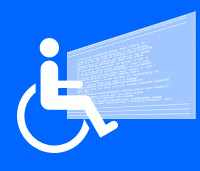You are viewing our site as a Broker, Switch Your View:
Agent | Broker Reset Filters to Default Back to ListIs Your Website Accessible to All?
April 09 2010

When considering all the functions a real estate professionals looks for in building and maintaining a professional website, accesibility for the disabled rarely enters the equation. But there are legal reasons to consider adding accessibility features to your website.
Did you know that of the 308,942,937 people in the United States, about 18% (according to the U.S. Census Bureau) of us have some kind of disability? That works out to about 62 million people, which is the combined populations of California, New York and Arizona.
In 1990, Congress enacted the Americans with Disabilities Act (ADA) to establish a clear and comprehensive prohibition of discrimination on the basis of disability. Among the protections provided in the ADA is the right for disabled persons to enjoy places of public accommodation fully and equally as non-disabled persons. Since the turn of the century, the definition of a public place has expanded to include the Internet since it is now an everyday tool for conducting business and recreational activities.
According to Linda Dunshee, Executive Director of Des Moines, IA's Link Associates, “The world is more geared toward the Internet now than ever. People with disabilities lose out on many opportunities the rest of us take for granted, like weather alerts, notifications, and calendars of events, because a website lacks accessibility for those with special needs.”
Accessibility is being addressed by a few forward-thinking businesses. Facebook has an accessibility page, as does Google, who takes it even further with a search engine for the visually impaired. In addition to meeting the needs of a large market segment, these companies know accessibility issues have made it to the courts and ADA compliance is now a crucial risk management practice.
There was a high profile case that Target settled a couple of years ago regarding the use of the website by a member of the public. In the settlement Target agreed to establish a $6 million fund from which members of the California settlement class can make claims. The National Federation of the Blind (NFB) was to certify the Target website through its Nonvisual Accessibility Web Certification (NFB-NVAC) program once the agreed-upon improvements were completed in early 2009. Target made the recommended changes, and in February of 2010 Target was awarded the Gold Level NFB-NVAC.
So what does this have to do with you? Most everyone has or is part of an organization which has a website. You need to know that in most cases it is not very difficult to add accessible design features to a website. At the most basic level, simple “alt” tags can be added to website images with just about any HTML editing program (“alt” tags help describe images to users who are using screen-readers, or who have website graphics turned off). Also, by limiting, or eliminating, the use of JavaScript
or Flash animation a website can become more accessible. An alternative to limiting JavaScript and Flash, a website could employ a text-only version of the site to make the site more accessible to users with disabilities.
To make “reasonable accommodations” for disabled persons accessing your website and to reduce potential liability, the Privacy Gurus® recommend you:
- Provide an Access Instruction Page for Visitors, also known as an “Accessibility Statement,” which includes email hyperlink for visitors to communicate problems with webpage accessibility.
- Provide support for text browsers.
- Attach "alt" tags to graphic images so that screen-readers can identify the graphic.
- Hyperlink photographs with descriptive text "D" to textually explain the picture.
- Caption all audio and video clips by using "CC" hyperlinks.
- Provide alternative mechanisms for online forms (such as email or voice/TTY phone numbers).
- Avoid access barriers such as the posting of documents in PDF, table, newspaper or frame format or requiring visitors to download software. If posting a PDF, the HTML text or ASCII file should also be posted.
If you would like Privacy Solutions to help you with accessibility for you or your organization’s website, please let them know. Contact Cristina and she will take a look at your website and send you a free Website Risk Check report. Privacy Solutions also have a low cost Accessibility Compliance package available which we will customize for your website.
As a part of this big wide world, each of us has now or will have our special needs. In this time of global interaction via the Internet, it is important to continue to assure that we all have equal rights to accessing our community.
Learn more about Website products and Web Design services.










